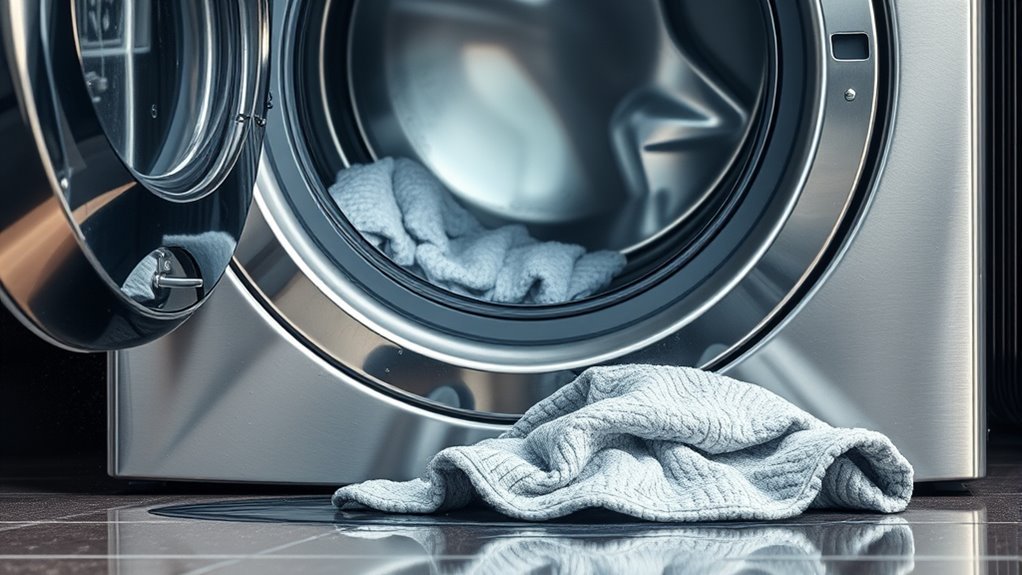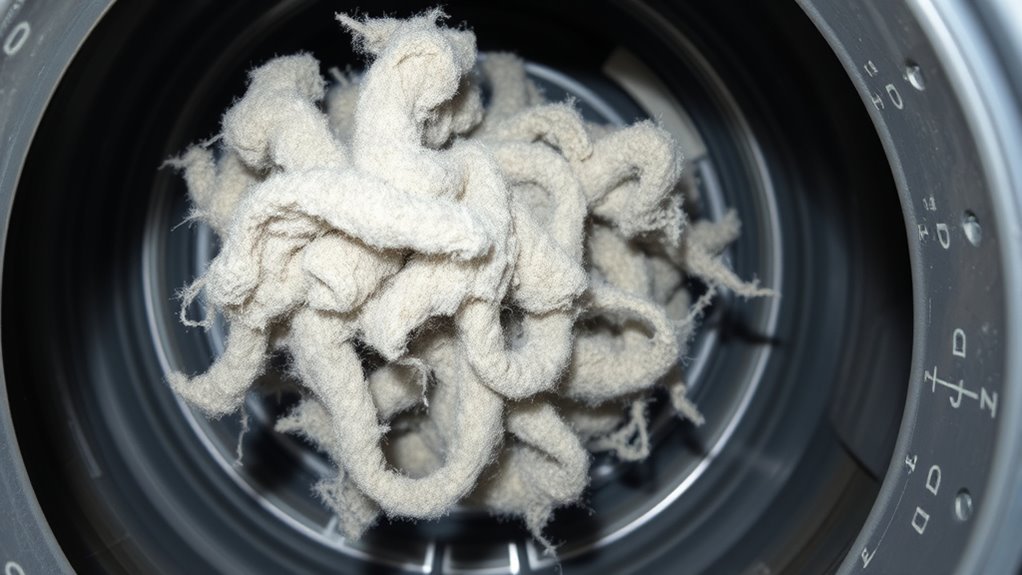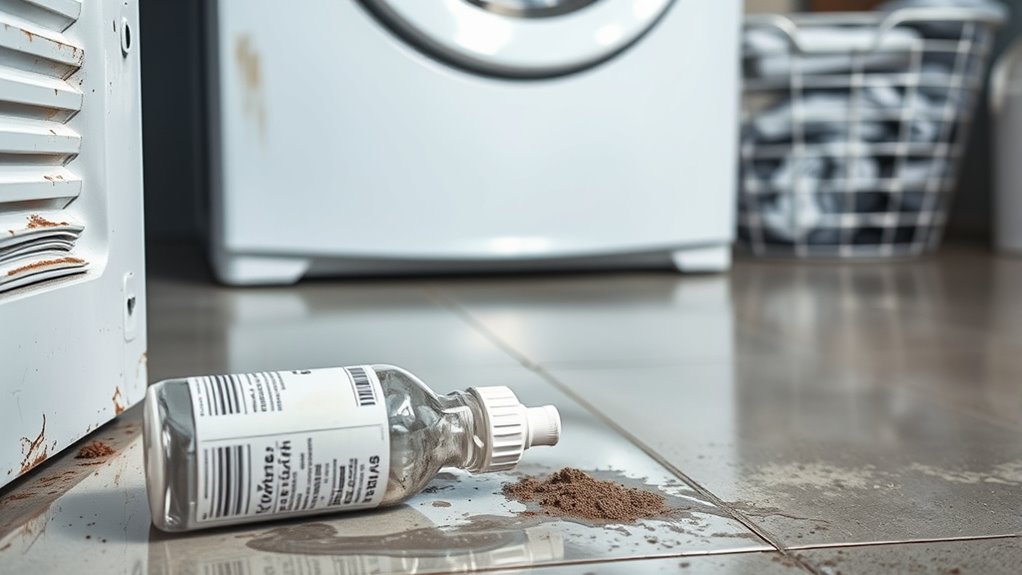Cleaning Mistakes That Damage Your Dryer
If you use too much water when cleaning your dryer, you risk damaging its electrical parts. Skipping the lint trap and vent cleaning causes airflow blockages and fire hazards. Harsh chemicals and abrasive tools can ruin the drum’s finish, leading to rust or fabric snags. Vacuuming delicate components without proper care can harm sensors. Neglecting professional maintenance means unexpected breakdowns. Stick with safe cleaning methods and regular checks to keep your dryer efficient and long-lasting—there’s more to uncover to protect your appliance.
Using Excessive Water During Cleaning

Although it might seem like a good idea to use plenty of water when cleaning your dryer, doing so can actually cause serious damage. You might think more water means a cleaner machine, but excessive moisture can lead to water damage inside electrical components, risking costly repairs. Instead, focus on the right cleaning frequency to maintain freedom from breakdowns without overdoing it. Wipe down surfaces with a damp cloth and avoid soaking any parts. Keeping your dryer dry during cleaning guarantees it runs smoothly and safely, allowing you to enjoy the convenience of quick laundry days. By balancing your cleaning routine and preventing water damage, you protect your freedom to rely on your dryer whenever you need it.
Neglecting to Clean the Lint Trap Regularly
If you don’t clean the lint trap regularly, your dryer’s efficiency will drop, and it could even become a fire hazard. Skipping lint trap maintenance restricts airflow, making your dryer work harder and longer, which wastes energy and shortens its lifespan. By clearing the lint after every load, you keep air circulating freely, boosting dryer efficiency and reducing drying time. Plus, regular cleaning frees you from costly repairs and potential safety risks. It’s a small habit that grants you the freedom to enjoy quick, effective drying without worry. Make it a simple routine—wipe or brush the lint trap each time to protect your dryer and keep your laundry routine running smoothly and safely.
Ignoring the Dryer Vent and Ductwork

You might not realize how dangerous ignoring your dryer vent and ductwork can be. Lint buildup restricts airflow, making your dryer work harder and increasing the risk of fire. Taking care of these parts is essential for safety and efficiency.
Lint Buildup Hazards
When lint builds up inside your dryer vent and ductwork, it can cause serious problems that affect both safety and performance. Neglecting lint trap maintenance puts you at risk of:
- Fire hazards – Lint is highly flammable and can ignite if it accumulates near heating elements.
- Overheating – Blocked airflow forces your dryer to work harder, increasing wear and safety risks.
- Carbon monoxide buildup – For gas dryers, poor ventilation can trap dangerous gases indoors.
- Frequent breakdowns – Excess lint stresses parts, leading to costly repairs and less freedom from appliance failures.
Staying on top of lint removal is crucial for dryer safety and your peace of mind. Don’t let laziness limit your freedom—keep vents clear and maintain your dryer’s performance by cleaning lint traps regularly.
Reduced Drying Efficiency
Although it’s easy to overlook, ignoring your dryer vent and ductwork greatly reduces drying efficiency. When lint and debris build up, air can’t flow freely, forcing your dryer to work harder and longer. This drag on your dryer performance not only wastes your time but also spikes energy consumption, cutting into your freedom from high utility bills. Keeping vents and ducts clean guarantees your dryer runs smoothly and efficiently, drying clothes faster while saving energy. Don’t let neglect hold you back—regular maintenance boosts energy efficiency and frees you from unnecessary hassle. Taking a few minutes to clear these pathways helps your dryer perform at its best, giving you more control over your time and resources without compromising on results.
Fire Risk Increase
Neglecting your dryer vent and ductwork doesn’t just slow down drying—it can also spark a serious fire hazard. When lint builds up, it blocks airflow, causing your dryer to overheat. This puts your home at risk and compromises fire safety.
To keep your freedom from worry and guarantee proper dryer maintenance, follow these steps:
- Clean the lint trap after every load.
- Inspect and clear your dryer vent and ductwork at least once a year.
- Use a vent brush or hire a professional to remove stubborn lint buildup.
- Avoid using plastic or foil vents; opt for metal ducts to reduce fire risk.
Using Harsh Chemicals on Dryer Surfaces

If you use harsh chemicals on your dryer’s surfaces, you risk damaging its finish and internal components. These strong cleaners might seem effective but can strip away protective coatings and corrode metal parts over time. Instead, choose surface safe cleaners or natural, harsh chemical alternatives that protect your dryer while keeping it clean.
| Harsh Chemical Alternatives | Benefits |
|---|---|
| Vinegar & Water | Non-toxic, gentle |
| Baking Soda Paste | Mild abrasive |
| Mild Dish Soap Solution | Safe on surfaces |
| Commercial Surface Safe Cleaners | Designed for dryers |
Opting for these options preserves your dryer’s look and function, giving you freedom from costly repairs and ensuring your appliance lasts longer.
Overlooking the Drum and Seals for Residue
When you clean your dryer, it’s easy to focus on the exterior and overlook the drum and seals where residue can build up. Ignoring these areas can cause damage and reduce efficiency. To keep your dryer running smoothly and give you the freedom to enjoy hassle-free laundry days, follow these essential steps for drum cleaning and seal maintenance:
- Wipe the drum interior with a damp cloth to remove lint and detergent buildup.
- Inspect the rubber seals around the drum for cracks or sticky residue.
- Use a mild cleaner to gently scrub seals, avoiding harsh chemicals that cause deterioration.
- Dry seals thoroughly to prevent mold and guarantee a tight, efficient seal.
Regular attention here preserves your dryer’s performance and lifespan.
Cleaning the Dryer While It’s Still Hot
Taking care of the drum and seals helps prevent buildup, but cleaning your dryer while it’s still hot can cause more harm than good. When you jump in right after a drying cycle, you risk burns or damaging sensitive parts due to hot surface precautions being overlooked. It’s tempting to clean immediately for quick results, but patience is key. Let your dryer cool down completely before you start cleaning to avoid warping or cracking components. Remember, drying cycle considerations aren’t just about efficiency—they also impact your safety and the machine’s longevity. By waiting, you protect yourself and maintain your dryer’s freedom to perform well. Don’t rush; respect the heat and clean smartly for lasting care.
Using a Vacuum Cleaner on Delicate Parts
Although using a vacuum cleaner might seem like a quick way to clear out lint and debris, you shouldn’t apply it directly to delicate dryer parts. Those delicate components can easily get damaged if you’re not careful. Instead, follow these steps to keep your dryer safe and free of lint:
- Use vacuum attachments designed for delicate surfaces to avoid scratching or breaking parts.
- Gently vacuum around vents and accessible areas without forcing the hose inside tight spaces.
- Avoid strong suction settings that can pull or dislodge sensitive components.
- Always unplug the dryer before cleaning to keep yourself and the machine safe.
Forgetting to Inspect and Clean the Moisture Sensor
After carefully vacuuming around your dryer’s vents and delicate parts, don’t overlook the moisture sensor. This small but crucial component detects how damp your clothes are and signals the dryer to stop at the right time. Forgetting to inspect and clean the moisture sensor can lead to inaccurate readings, causing your dryer to run longer than necessary or shut off prematurely. Regular sensor maintenance is important to keep your dryer efficient and your energy bills low. Simply wipe the sensor with a soft cloth and a bit of rubbing alcohol to remove residue buildup. By taking a few minutes for sensor maintenance, you guarantee your dryer works smarter, giving you the freedom to enjoy perfectly dried clothes without unnecessary wear or wasted energy.
Applying Abrasive Tools to the Interior Drum
One common mistake people make is using abrasive tools to clean the interior drum of their dryer. While it might seem like a quick fix, harsh scrubbing can damage the drum’s finish, leading to rust or fabric snags. For proper drum care, you want to avoid anything that scratches or wears down the surface. Instead, choose gentle cleaning materials and follow these tips:
- Use a soft cloth or sponge with mild detergent.
- Avoid steel wool, scrubbing pads, or abrasive brushes.
- Wipe the drum dry to prevent moisture buildup and rust.
- Clean regularly to keep the drum smooth and free of residue.
Skipping Professional Maintenance Checks
Taking care when cleaning the drum is important, but it’s just one part of keeping your dryer in good shape. Skipping professional maintenance checks can cost you freedom from unexpected breakdowns. A professional inspection guarantees preventive maintenance is done right, catching issues you might miss. By scheduling regular check-ups, you keep your dryer running efficiently and safely.
| Benefit | Why It Matters | Your Freedom Gains |
|---|---|---|
| Early Problem Detection | Avoids costly repairs | Saves time and money |
| Improved Efficiency | Maintains ideal performance | Cuts energy costs |
| Safety Assurance | Reduces fire risk | Peace of mind |
| Extended Appliance Life | Delays replacement needs | Keeps you stress-free |
Don’t let skipping professional inspections limit your freedom to enjoy hassle-free drying!
Frequently Asked Questions
How Often Should I Replace My Dryer’s Lint Trap Filter?
You should replace your dryer’s lint trap filter about once a year or whenever it shows signs of wear and tear. Regular lint trap maintenance is key to keeping your dryer performance ideal and efficient. Don’t wait until it’s damaged; fresh filters help prevent overheating and reduce fire risks. Staying on top of this simple task gives you the freedom to enjoy hassle-free drying without unexpected breakdowns or energy waste.
Can Dryer Sheets Cause Buildup Inside the Dryer Drum?
You might think dryer sheets are magic, but they can actually turn your dryer drum into a sticky mess! Dryer sheet residue and fabric softener buildup can coat the inside, making your clothes less fresh and your dryer less efficient. If you want freedom from constant maintenance, consider alternatives like wool dryer balls or liquid softeners. That way, you keep your dryer clean and your laundry game strong without the sticky buildup hassle.
What Is the Best Way to Prevent Static Cling in Dryers?
To prevent static cling in your dryer, you’ll want to focus on static reduction techniques that keep your clothes feeling fresh and free. Using fabric softeners is a popular choice—they coat your fabrics, reducing friction that causes static. You can also toss in dryer balls made of wool or rubber for a chemical-free option. These methods help you enjoy your clothes without that annoying cling, giving you the freedom to wear what you love comfortably.
How Can I Tell if My Dryer Vent Is Blocked Without Inspection?
Did you know that 34% of dryer-related house fires are caused by blocked vents? If you notice your dryer takes longer to dry clothes or feels hotter than usual, those are signs of airflow issues. Reduced dryer performance often means a vent blockage. You don’t need to inspect it immediately; just trust your senses—slow drying and excess heat mean it’s time to clear that vent and keep your freedom from laundry hassles.
Are There Any Natural Alternatives to Commercial Dryer Cleaning Products?
If you’re looking for natural cleaning and eco friendly options, you’ve got some great choices. You can use a mix of white vinegar and baking soda to break down lint and residue without harsh chemicals. These natural cleaning methods keep your dryer fresh and safe, plus they’re better for the environment. You don’t have to rely on commercial products—embrace these freedom-friendly, green alternatives to keep your dryer running smoothly.






